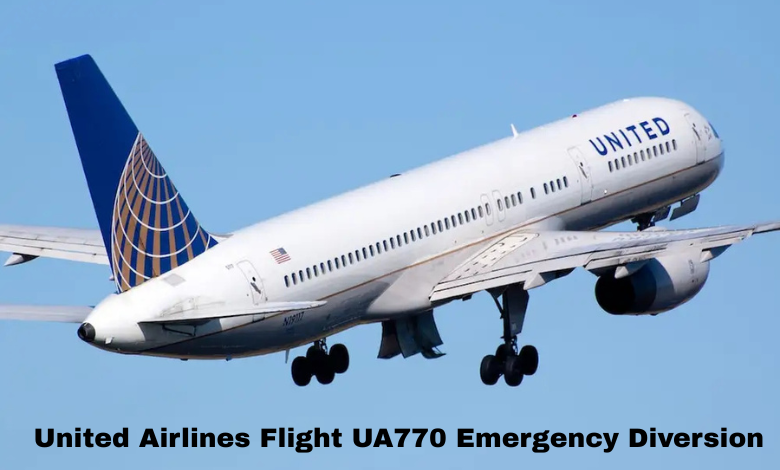On a transatlantic journey from Barcelona to Chicago, United Airlines Flight UA770 was forced to make an emergency landing at London Heathrow Airport following a mid-air technical issue. The incident, which unfolded over the Atlantic Ocean, involved a suspected cabin pressurisation problem that prompted the flight crew to declare a general emergency and issue the aviation code 7700. The Boeing 787-9 Dreamliner, carrying 257 passengers and 12 crew members, landed safely in London, with no injuries reported. The crew has since been praised for their calm and professional handling of the situation.
This blog post explores the sequence of events that led to the emergency diversion, the nature of the technical issue, the response from the flight crew, and the aftermath of the incident.
Background of United Airlines Flight UA770
United Airlines Flight UA770 is a regularly scheduled international service operating between Barcelona–El Prat Airport (BCN) in Spain and Chicago O’Hare International Airport (ORD) in the United States. The aircraft used on this route is typically a Boeing 787-9 Dreamliner, known for its fuel efficiency and long-range capability.
On the day of the incident, Flight UA770 took off from Barcelona on time and proceeded along its planned route over Western Europe before entering transatlantic airspace. The aircraft had reached its cruising altitude of approximately 37,000 feet when the flight crew became aware of a possible cabin pressurisation issue.
Timeline of the Emergency Diversion
Cruise Phase – Detection of Anomaly:
Roughly two hours into the flight, while cruising over the Atlantic Ocean, the flight crew observed irregularities associated with the cabin pressure system. Initial indicators from the cockpit suggested an abnormality, though not an immediate decompression. The decision was made to closely monitor the system for any deterioration.
Escalation – Declaration of Emergency:
As a precautionary measure, and in line with airline protocol and international aviation safety standards, the pilots decided to declare a general emergency. The squawk code 7700 was entered into the aircraft’s transponder, signaling air traffic control that the flight was experiencing a critical situation requiring priority handling.
Communication and Coordination:
Following the emergency declaration, the pilots initiated contact with air traffic controllers in the United Kingdom to coordinate a diversion plan. Given the aircraft’s location and the facilities available, London Heathrow Airport (LHR) was selected as the most suitable alternate destination.
Controllers worked quickly to provide the flight with a safe and efficient path to Heathrow, prioritising its approach over other commercial traffic. Emergency services at Heathrow were placed on standby as part of standard procedure.
Descent and Approach:
The aircraft began a controlled descent from cruising altitude. Throughout the descent, the crew kept passengers informed, ensuring a calm cabin environment. There were no signs of rapid decompression or oxygen mask deployment, indicating that the pressurisation issue did not escalate into an acute emergency.
Landing at Heathrow:
Flight UA770 landed without further incident at London Heathrow. Emergency vehicles followed the aircraft as it taxied to a remote stand, where technicians and emergency personnel inspected the plane. Passengers were disembarked and taken through immigration as plans were made for their onward travel.
The Aircraft: Boeing 787-9 Dreamliner
The Boeing 787-9 is part of the Dreamliner series, a wide-body aircraft known for its long-range capabilities and advanced systems. Its pressurisation and environmental control systems are among the most modern in commercial aviation. Despite this, technical issues can still arise, and protocols exist to ensure safe handling.
In this case, the suspected issue involved the cabin pressurisation system, which is responsible for maintaining a safe and comfortable atmospheric pressure inside the aircraft cabin during high-altitude flight. Malfunctions in this system can range from minor sensor issues to more serious failures, such as gradual or rapid decompression.
Crew Response and Training
United Airlines flight crews undergo extensive training to prepare for in-flight emergencies. This includes simulated scenarios involving pressurisation failures, engine issues, and other airborne malfunctions. The crew of UA770 followed established procedures precisely—monitoring the situation, declaring an emergency, communicating with air traffic control, and executing a safe diversion.
Eyewitness accounts from passengers suggest that the crew maintained a professional demeanor, reassuring travelers and providing timely updates. No panic or confusion was reported, which aviation safety experts attribute to both the experience of the pilots and the training of cabin crew.
Emergency Code 7700 Explained
In aviation, the squawk code 7700 is universally recognized as a general emergency signal. When entered into the aircraft’s transponder, it alerts all air traffic control facilities that the aircraft is facing an emergency, regardless of its nature. This ensures immediate prioritisation and response.
The use of code 7700 does not specify the exact type of emergency but serves as a high-priority indicator that the aircraft may require expedited routing, an immediate descent, or emergency services upon landing.
In the case of UA770, this code was entered after the flight crew evaluated the situation and deemed that continuing the transatlantic crossing posed an unnecessary risk without first resolving the technical anomaly.
Passenger Experience
Following the emergency landing, several passengers spoke to media outlets and shared their accounts. Most described the event as calm and well-managed. Cabin crew communicated clearly that a precautionary landing was being made and assured passengers there was no immediate danger.
There were no reports of medical emergencies, injuries, or distress among passengers. The flight’s diversion meant some disruption to travel plans, with rebookings required for those en route to Chicago. United Airlines provided accommodation and support at Heathrow for affected passengers and made arrangements to transport them to their final destinations.
Technical Investigation and Aircraft Inspection
After the aircraft was safely parked at Heathrow, United Airlines maintenance teams, along with local aviation authorities, began a thorough inspection of the aircraft to determine the cause of the issue. At the time of writing, the specific nature of the technical fault has not been publicly disclosed.
However, standard procedure includes examining the cabin pressurisation system, including the outflow valves, pressure controllers, and the environmental control system. Data from the flight data recorder and maintenance logs will also be reviewed.
Depending on findings, components may be replaced or systems recalibrated before the aircraft is cleared to return to service. The UK’s Civil Aviation Authority (CAA) and the U.S. Federal Aviation Administration (FAA) may both be involved in reviewing the incident, particularly if a systemic issue is suspected.
Regulatory Protocols and Safety Oversight
Incidents like the one involving UA770 are not uncommon in commercial aviation. Aircraft are complex machines, and technical issues can develop despite rigorous maintenance schedules. What matters in these situations is the response—and in this case, it was by the book.
The International Civil Aviation Organization (ICAO) and national authorities such as the FAA and EASA (European Union Aviation Safety Agency) set stringent guidelines on how airlines must respond to in-flight anomalies. These include immediate reporting, safe diversion procedures, post-incident maintenance checks, and if necessary, fleet-wide inspections.
United Airlines, like other major carriers, operates under a Safety Management System (SMS) framework that promotes proactive hazard identification and continuous improvement in safety practices.
Airline Response and Passenger Support
United Airlines issued a statement shortly after the incident, confirming the diversion and emphasizing the safety of passengers and crew. The statement acknowledged the crew’s professional handling and confirmed that all passengers were accommodated after landing.
The airline also activated its customer care protocols, offering rebooking options, lodging, and meal vouchers to passengers affected by the diversion. While disruptions are inconvenient, United’s prompt support helped mitigate the impact.
For passengers who missed connecting flights in Chicago or who had specific travel deadlines, the airline’s customer relations team provided additional assistance.
Industry Perspective on Diversions
In-flight diversions due to technical anomalies are taken seriously across the aviation industry. While not common, they are part of routine safety management. Most aircraft are equipped to handle a wide range of issues in-flight, and pilots are trained to make judgment calls that prioritize safety over schedule.
In the case of UA770, the crew’s choice to divert rather than continue a multi-hour flight over the Atlantic was a demonstration of aviation safety principles at work. Diversions often cost airlines both time and money, but they are essential safeguards built into the operational structure of commercial flying.
Aviation analysts have noted that this incident serves as another example of why redundancy, training, and planning are critical in ensuring safe outcomes.
Conclusion
The emergency diversion of United Airlines Flight UA770 to London Heathrow was a calculated and controlled response to a suspected cabin pressurisation issue. With 257 passengers and 12 crew members on board, the flight crew demonstrated professionalism in declaring a general emergency, coordinating with air traffic control, and executing a safe landing.
All passengers disembarked safely, and no injuries were reported. United Airlines provided logistical support, and an investigation into the aircraft’s systems was initiated.
This incident underscores the importance of adherence to safety procedures and the effectiveness of training protocols in handling high-pressure scenarios. While technical anomalies are an inherent risk in aviation, how they are managed often makes the difference. In the case of UA770, the outcome was as positive as possible under the circumstances.




